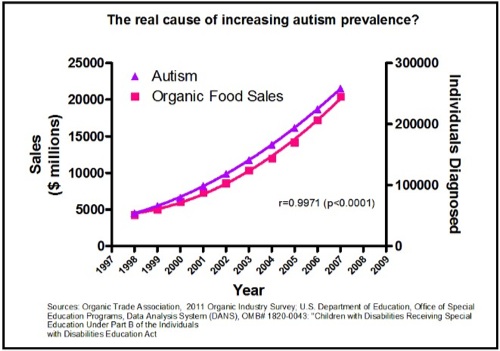
Claim: One in two children will be autistic by 2025 due to use of glyphosate on food crops.
Example: [Collected via e-mail, October 2014]
I've seen this same article floating around on Facebook and since I work with children with autism, I was hoping to check up on the veracity of this article:
Senior MIT Scientist Warns 1 In 2 Children Will Have Autism by 2025
The overuse of Monsanto's Roundup herbicide on our food is causing glyphosate toxicity and it is now being considered as the single most important factor in development of autism and other chronic disease. At a recent panel discussion about GMOs, a senior scientist has stated that one in two children will be autistic by 2025...
Origins: On
prognostication made "at a conference" in early December by Stephanie Seneff, PhD (whose web biography described her as a "Senior Research Scientist at the MIT Computer Science and Artificial Intelligence Laboratory," not an individual specializing in epidemiology.) The precise location, date, and general scope of the December 2014 conference in question was not disclosed in the article, but a reference was made to the general subject of genetically modified organisms (GMOs).
The headline's reference to looming autism diagnosis spikes was continued in the article's first line: "Evidence points to glyphosate toxicity from the overuse of Monsanto's Roundup herbicide." After describing Seneff's background in computer science, the article continued:
At a conference last Thursday, in a special panel discussion about GMOs, she took the audience by surprise when she declared, "At today's rate, by 2025, one in two children will be autistic." She noted that the side effects of autism closely mimic those of glyphosate toxicity, and presented data showing a remarkably consistent correlation between the use of Roundup on crops (and the creation of Roundup-ready GMO crop seeds) with rising rates of autism. Children with autism have biomarkers indicative of excessive glyphosate, including zinc and iron deficiency, low serum sulfate, seizures, and mitochondrial disorder.
The article conflated a number of unrelated claims and beliefs about autism and its causes, jumping from pesticides to vaccines and back again in the course of its travels. A USDA report issued in
Of course, autism is a complex problem with many potential causes.
In addition, as we have previously reported, the number of adverse reactions from vaccines can be correlated as well with autism, though Seneff says it doesn't correlate quite as closely as with Roundup. The same correlations between applications of glyphosate and autism show up in deaths from senility.
Both the article and Seneff's biography mention work with the group AutismOne, a group of parents (not scientists) who've espoused the fervent belief autism is caused not by genetic factors but environmental contaminants. An
AutismOne is a non-profit charity organization 501(c)(3) started by a small group of parents of children with autism. Parents are and must remain the driving force of our community, the stakes are too high and the issues too sacred to delegate to outside interests. AUTISM IS A PREVENTABLE/TREATABLE BIOMEDICAL CONDITION. Autism is the result of environmental triggers. Autism is not caused by "bad" genes and the epidemic is not the result of "better" diagnosis. Children with autism suffer from gut bugs, allergies, heavy metal toxicity, mitochondrial disorders, antioxidant deficiencies, nutritional deficiencies and autoimmune diseases — all of which are treatable.
Both Seneff and AutismOne appear to reject the accepted findings of science on the heretofore not fully understood causes of autism, namely in terms of genetics. The claim also deviates from mainstream science on whether autism is truly more prevalent or whether diagnostic criteria and awareness have caused the increase in the number of children diagnosed with the disorder each year. The Centers for Disease Control (CDC) explained in a
The global prevalence of autism has increased twentyfold to thirtyfold since the earliest epidemiologic studies were conducted in the late 1960s and early 1970s. At that time, prevalence estimates from European studies were one in 2,500 children in the population, and by the 2000s prevalence estimates from large surveys were
The article stated that Seneff made very specific claims at the
the information in the article, it appeared Seneff's claims rested on somewhat shaky foundations.
Regarding autism rates in 2025, the "50 percent of children" estimate looks to be a rudimentary extrapolation of an apparent uptick in autism diagnoses in recent years. Particularly if the cause of such an uptick is improvements in screening and access to diagnostics, it's just as likely the rate would plateau or even dip in the near future when considered by itself. No explanation was proffered (in the article, at least) to justify an affirmative belief the prevalence of autism would rise so drastically (and by that logic we might assume that by 2050,
Even disregarding the sloppy mathematics, the claim's very basis (that glyphosate is the cause of a perceived increase in autism) is unsupported. No mention was made of how glyphosate was isolated and shown to be a cause (or even a factor) in some or any cases of autism in the article. No autism spikes near agricultural facilities were described, nor was any definitive causative link at all cited by the article (and presumably, Seneff) to back up the purported link between glyphosate and autism rates anywhere other than the imaginations of those making the claim. The single link of merit made within the article (to a USDA report) made absolutely no mention of autism at all but was misleadingly arranged to suggest a connection.
What the claim seemed to hinge on largely was a correlation/causation fallacy: Because [unclear activity involving glyphosate] occurred, a corresponding rise in autism diagnoses must be due to that unspecified issue with glyphosate. Claims of a similar nature have been dispelled with graphs like the following that show how difficult (or simple) it is to "prove" any one cause correlates with any one effect:

Clearly the graph is
Whether educated or not, guesswork is only the start of research in epidemiology, and no published research exists to prove (or even suggest) a link between glyphosate and autism. No evidence was presented in the article to provide context for why glyphosate (or GMOs) would be any more likely to account for the presumed increase than other environmental factors, and it appeared the only visible connection between the two was their inclusion on a graph presented at a conference of an indeterminate nature.
Last updated: 21 December 2015
Sources: |
"USDA Report Says Pesticide Residues in Food Nothing to Fear." Reuters. 19 December 2014.
